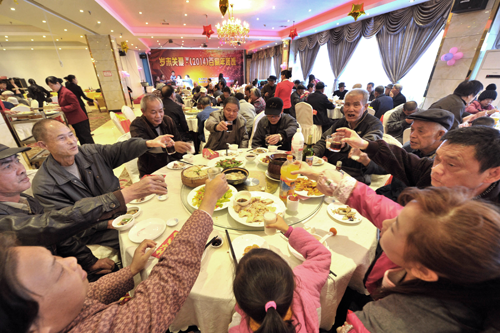
Food is Culture - Especially in China
“The Story of China is the Story of Food”
— Quoted from a BBC Documentary
Food in China embodies harmony, symbolism, and ritual, with each dish and dining practice shaped by millennia of tradition. From the symbolism of dumplings and noodles to the quiet ritual of tea pouring and finger tapping, the Chinese dining experience is rich with meaning and cultural intelligence.
China | Explore Global Cultures | Explore Global Celebrations | View Our Site Guide
China’s Culinary Culture: More Than Just a Meal
In China, food is never just a meal — it’s a deeply woven cultural experience that reflects history, hierarchy, harmony, and hospitality. Every dish carries meaning, and every dining gesture communicates unspoken values. Whether gathered at a family table or a business banquet, the Chinese meal is where trust is built, relationships are deepened, and tradition is honored. To understand Chinese food is to begin understanding China itself.
Harmony, Symbolism, and the Five Flavors
Chinese culinary philosophy emphasizes balance — in taste, texture, color, and even temperature. Meals are designed not just to nourish, but to align the body and spirit. The Five Flavors — sweet, sour, bitter, salty, and umami — are often harmonized in a single meal, or even within a single dish, reflecting the yin-yang interplay of opposites working in harmony.
Symbolism is layered into the dining experience. A whole fish represents abundance, especially during Chinese New Year. Dumplings resemble ancient gold ingots and are eaten for prosperity. Long noodles, never cut, symbolize longevity on birthdays. Food becomes a language of hopes, blessings, and cultural continuity. — one that’s spoken with chopsticks, not words.
Ritual and Reverence: The Kitchen God
The cultural and spiritual importance of food in China dates back thousands of years. In traditional households, a portrait of Zaoshen — the Kitchen God — was placed above the stove. Believed to report on the family’s behavior to the Jade Emperor in heaven, Zaoshen symbolized the moral weight of the kitchen and the act of cooking.
Each year before the Lunar New Year, families would burn his image and offer sticky sweets, hoping his report would be favorable. On New Year’s Day, a new portrait was hung to welcome his return. This ritual underscores the deep belief that what happens in the kitchen — the heart of the home — reflects the family’s values and fate.
A Nation of Many Tastes: The Eight Great Cuisines
China’s culinary diversity is vast, shaped by geography, climate, and history. The Eight Great Cuisines (Lu, Yue, Su, Min, Xiang, Zhe, Hui, and Chuan) represent regional traditions — from the bold spices of Sichuan to the delicate freshness of Jiangsu.
No single dish can represent China. Instead, the Chinese table is a mosaic of local specialties, cooking styles, and seasonal ingredients that reflect the country’s immense cultural depth.
While China’s culinary heritage is vast and deeply regional, many dishes associated with “Chinese food” in the West — such as General Tso’s Chicken, Chop Suey, Crab Rangoon, or even Egg Foo Young — are Chinese-American inventions. Even the fortune cookie, often presented at the end of a meal in the U.S., has no roots in mainland China. These adaptations reflect a fascinating culinary fusion, but they also highlight how easily assumptions about authenticity can be misleading.
Cultural Concepts at the Table: Guanxi and Mianzi
In Chinese culture, meals often serve as the setting where business relationships are forged and social dynamics are navigated. Two key concepts come into play: guanxi (关系), the network of trusted relationships, and mianzi (面子), or “face,” which relates to reputation, dignity, and social standing.
Hosting a banquet can be a powerful gesture of respect and goodwill. The choice of dishes, seating arrangements, and how toasts are exchanged all carry meaning. Accepting or declining an invitation, pouring drinks in the right order, or using the wrong tone can impact not just the mood — but the outcome of a negotiation or partnership.
Dining Etiquette: From Confucius to the Lazy Susan
- 🥢 Guests are seated by status, with the most honored seat farthest from the entrance.
- 🥢 The host signals when the meal begins — don’t start eating on your own.
- 🥢 Never stick chopsticks upright in a bowl of rice — it resembles funeral incense.
- 🥢 Avoid tapping chopsticks on bowls or plates, which is considered impolite.
- 🥢 Tea — like all beverages — should be poured for others before yourself. This act of attentiveness reinforces group harmony and shows respect.
- 🥢 To express gratitude when someone pours tea, guests may tap two fingers on the table — a tradition linked to a Qing emperor who served his guards while in disguise. Forbidden from bowing, they used this discreet gesture to show respect — a custom still practiced today.
- 🥢 The Lazy Susan is common in restaurants, but courtesy and attentiveness remain central to the meal.
Final Reflection: Why the Table Still Matters
In a rapidly modernizing China, some traditions have evolved — but many remain deeply rooted. Whether in a five-star Shanghai hotel or a family home in Guangdong, the Chinese table continues to serve as a reflection of cultural values.
It is a place where relationships are deepened, where trust is built, and where unspoken meanings are conveyed as clearly as words. For global professionals, learning the etiquette, expectations, and deeper cultural frameworks around Chinese food is more than a courtesy — it’s a strategic advantage. Discover more cultural insights and global traditions here.
Home | Services | Culture | Insights | About Us | Work with Us | Contact
Email Us | www.culturalsavvy.com | ©1999–2025 Cultural Savvy. All Rights Reserved. Terms of Use
